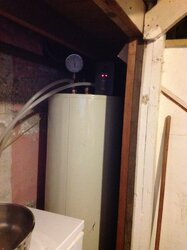Hey guys...
Well I'm working towards building a solar hydronic heating system for my house. It will be an open system that heats a large (250+ gallon) insulated water tank. From what I've researched, the solar heat panels will be able to keep the tank in the 120-150F range.
I'm looking to supplement this for long periods of clouds, etc... by adding a heating coil to my stove. Again, an open system... water pumped from the bottom of the tank through the coil and returned to the top of the tank. The tank will not be sealed so no risk of pressure build up, etc... if a pump fails, the coil would just drain back to the tank.
I'm not overly worried about extracting every bit of heat that I can from the stove... Just want enough to help keep the tank warm.
The fluid in the tank will then be pumped through radiant baseboard heaters in several rooms and returned to the tank (again, open system here too) or heat exchangers placed in the duct work of the original forced air furnace. May also add a large coil to the inside of the tank plumbed inline with the electric water heater to pre-heat the incoming water and reduce the amount of time the element is used. (Not a priority at the moment)
So.. with all that said... what would be the best way of going about this? I've seen copper coils placed outside of the fire box (between the fire box and outer sheet metal skin).. I've seen coils placed inside the box.. I've seen them in the flue. I personally want to avoid anything placed in the flue... so either inside the box on top of the baffle plate or on the outside of the box.
What would be best? Would a copper coil hold up to internal firebox temps? Has anyone had any luck getting real heat from outside the fire box? Really leaning towards a large copper coil on top of the firebox (not internal).
I'm leaning towards building the insulated tank in the crawlspace as to make the heating coil the highest point in the stove/water system so any pump failure would result in draining of the coil back to the tank. I would think that with an open system, even if water was still in the coil, it would just gradually boil off and re-condense/return to the tank (worst case scenario).
Any input on this? The stove burns hot/clean... has a vertical 8" double wall flue from stove to cap (double wall from stove to ceiling, double wall class A from ceiling to cap) and I want to keep it burning clean.
Well I'm working towards building a solar hydronic heating system for my house. It will be an open system that heats a large (250+ gallon) insulated water tank. From what I've researched, the solar heat panels will be able to keep the tank in the 120-150F range.
I'm looking to supplement this for long periods of clouds, etc... by adding a heating coil to my stove. Again, an open system... water pumped from the bottom of the tank through the coil and returned to the top of the tank. The tank will not be sealed so no risk of pressure build up, etc... if a pump fails, the coil would just drain back to the tank.
I'm not overly worried about extracting every bit of heat that I can from the stove... Just want enough to help keep the tank warm.
The fluid in the tank will then be pumped through radiant baseboard heaters in several rooms and returned to the tank (again, open system here too) or heat exchangers placed in the duct work of the original forced air furnace. May also add a large coil to the inside of the tank plumbed inline with the electric water heater to pre-heat the incoming water and reduce the amount of time the element is used. (Not a priority at the moment)
So.. with all that said... what would be the best way of going about this? I've seen copper coils placed outside of the fire box (between the fire box and outer sheet metal skin).. I've seen coils placed inside the box.. I've seen them in the flue. I personally want to avoid anything placed in the flue... so either inside the box on top of the baffle plate or on the outside of the box.
What would be best? Would a copper coil hold up to internal firebox temps? Has anyone had any luck getting real heat from outside the fire box? Really leaning towards a large copper coil on top of the firebox (not internal).
I'm leaning towards building the insulated tank in the crawlspace as to make the heating coil the highest point in the stove/water system so any pump failure would result in draining of the coil back to the tank. I would think that with an open system, even if water was still in the coil, it would just gradually boil off and re-condense/return to the tank (worst case scenario).
Any input on this? The stove burns hot/clean... has a vertical 8" double wall flue from stove to cap (double wall from stove to ceiling, double wall class A from ceiling to cap) and I want to keep it burning clean.



 -
-